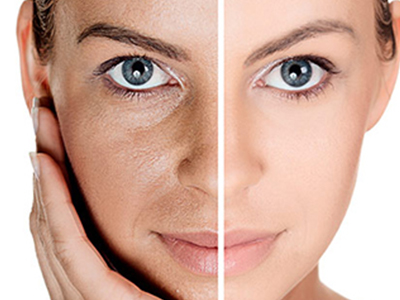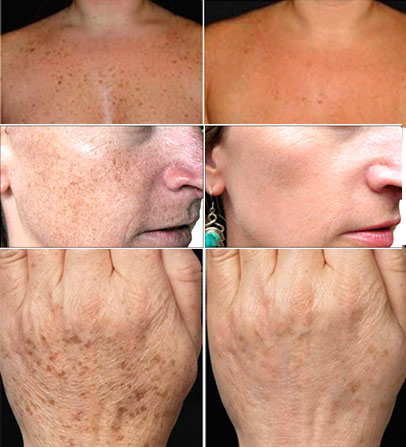

Reds and Browns be GONE! They’re not freckles. It’s sun damage! Those spots are solar lentigines and they are called liver spots and age spots for good reason. Nothing ages our skin faster than excessive, unprotected exposure to the sun.
Sun damage can come in many forms and you might not even realize that you have it. Nor might you realize that the visible effect of sun damage on your skin can easily be erased with laser and light treatments.
Let’s start by looking at some of the ways the appearance and health of our skin can be affected by sun exposure.
Brown Spots: The most common form of sun damage will appear as small tan, or brown spots which tend to be darker than usual freckles and that do not go away in the winter. They vary in size and usually appear on the face, neck, chest, back, hands, arms, or anywhere that gets a lot of sun exposure. Some sun spots are large and can darken and thicken over time. Some can become skin cancer.
Flushing: Excessive exposure to ultraviolet rays can cause a permanent stretching of small blood vessels in the skin. This can result in a red pigmentation in the skin that may be mottled in appearance.
Wrinkles and Sagging: Ultraviolet rays break down collagen and elastin, the skin’s connective tissue, which causes the skin to lose its strength, elasticity and tone. Two people of the same age can appear decades apart in appearance depending on how much sun exposure they have had in their lives.
Poikiloderma: Reddish-brown pigmentation that is splotchy and uneven and may be sprinkled with white spots is also sun damage. This type of sun damage is most common on the neck and chest when skin is chronically exposed to the sun.
Actinic Keratosis: These rough, scaley, raised patches that range in colour from pale to brown are also caused by sun exposure. They too can become cancerous.
Melasma: Brown discolorations that do not look like spots but more like stains are usually Melasma, a condition often triggered by hormones. Melasma is not sun damage but will darken dramatically after very little sun exposure.
The best course of treatment to erase the visible effects of sun damage can vary depending on the type and degree of damage and how much natural melanin is in the skin. The space of this article cannot accommodate an explanation of all the options, but let’s explore the benefits of one easy solution known as phototherapy. Intense Pulsed Light, also known as IPL, can target browns and reds on people with fair to medium skin tones. Skinpossible uses a medical-grade IPL known as a BBL that allows our skilled technicians to choose a wavelength and pulse width to target brown or red pigment at the appropriate depth for each. The BBL has built-in cooling which can make the use of high energy safe. With cooling, the skin can tolerate multiple passes to target browns and reds simultaneously in the same treatment.
A single treatment will make a dramatic improvement for browns and multiple treatments repeated two weeks apart can restore skin to very even tones. Photorejuvenation can reduce overall redness, flushing and tiny blood vessels associated with rosacea, high blood pressure or injury. The underlying skin condition that causes rosacea will eventually resurface so periodic maintenance treatments will be required. Reds are more stubborn and will often require a series of three to five treatments repeated four weeks apart. Alternative treatments are available for Melasma and Actinic Keratosis.
Reds and Browns be GONE!

